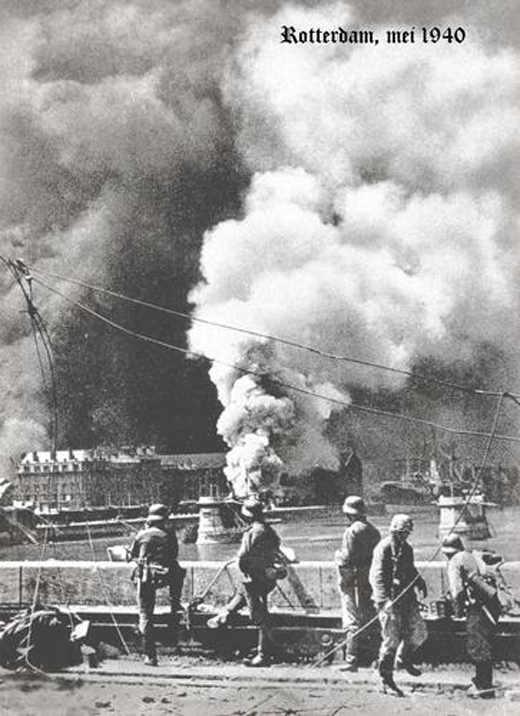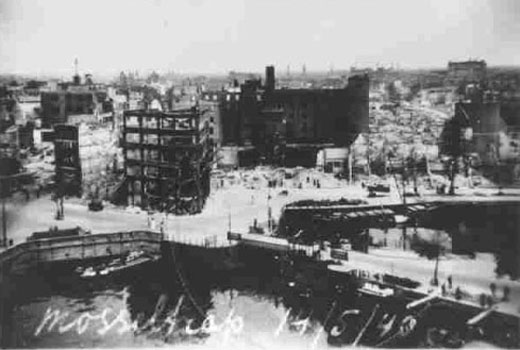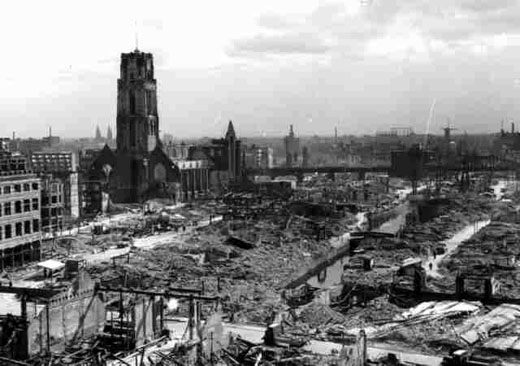Air Operations, Europe
In an attempt to crush stubborn Dutch resistance and bring tentative ceasefire negotiations to a quick conclusion, 100 He-111s are sent to bomb the center of Rotterdam. The Dutch garrison then offers to surrender but 60 of the bombers cannot be recalled and start huge fires among fats and margarine stores. The fires burn for days. 30,000 people are feared dead (revised total: 980); 78,000 homeless. Over 20,000 buildings are destroyed.
While attacking German troop concentrations in the Sedan bridgehead, 45 Battles and Blenheims are shot down out of a force of 109, the largest loss ever by the RAF up to this point.
[Battle of the Atlantic
- The Polish troopship Chrobry (11,442t) is badly damaged by a German low-level bombing attack in Vestfjord. The vessel is set afire by the bombing and is abandoned. 11 of her crew are lost. 1,000 survivors are taken off by the British destroyer Wolverine and sloop Stork. The survivors are taken to Harstad.
- The Belgian steamer Ville de Bruges (13,869t) is badly damaged by German bombing in the Scheldt River 10 miles from Antwerp. 3 of her crew are lost. She is beached and abandoned as a total loss.
- The Swedish steamer Framnas (721t) is seized by German troops Stavanger. She is renamed Borgen for German service.
Rotterdam Burning |
 |
Britain, Home Front
Anthony Eden announces the formation of the Local Defensee Volunteers. Appeals are made for volunteers, aged 17 to 65, for this new home-defense force. Recruiting begins for this volunteer force from men in reserve occupations or too old or young for military service. Within hours 250,000 men have volunteered. In July the far more-effective title of Home Guard is chosen.
[Diplomatic Relations
Prime Minister Churchill writes to President Roosevelt appealing for American aid against the Nazi aggressors.
[Norway
A Polish transport, the Chobrys, carrying a large part of the British 24th Guards Bde to join the holding forces south of Narvik is bombed and sunk by a German He-111. Much equipment is lost.
[Western Front
After a surrender demand has been submitted but before it has expired, Rotterdam is very heavily bombed by the Luftwaffe killing 980 people and destroying 20,000 buildings. The Dutch Commander in Chief, Gen Henri Winkelman, decides that he must surrender 'to prevent annihilation'.
|
|
The German armor, led by Guderian's 1st Pzr Div at Sedan, pours across the Meuse there and at Dinant. French tank units, poised to stage a counterattack against the German armored formations in the area, are ordered to disperse over a front of 12 miles. Almost all day wave after wave of Allied bombers, numbering nearly 200 and including obsolete Battles and Amiot 143s, make suicidal attacks on German pontoon bridges at Sedan and the German reinforcements streaming over the Meuse, but with little effect. Me-109s, German anti-aircraft and small arms fire destroy 85 aircraft, 35 of them British. The bridges are undamaged. A French tank-infantry counterattack in the Sedan sector fails. Once across the river the Germans drive west, cutting a huge gap between Corap's 9th and Huntziger's 2nd Army. Huntziger has no orders on which way to retreat. Corap's Army retires to Rocroi. Gen Touchon is appointed to command the French reserves that are earmarked to plug the gap developing between the 9th and 2nd French armies west of Sedan. There is a breach of 50 miles between Dinant and Sedan, and during the afternoon Gen Guderian brings almost all his tanks across the Meuse.
Gen Walther von Reichenau is ordered to attack enemy positions between Louvain and Namur with his 6th Army. The operation is timed for the next day.[MORE]
[
